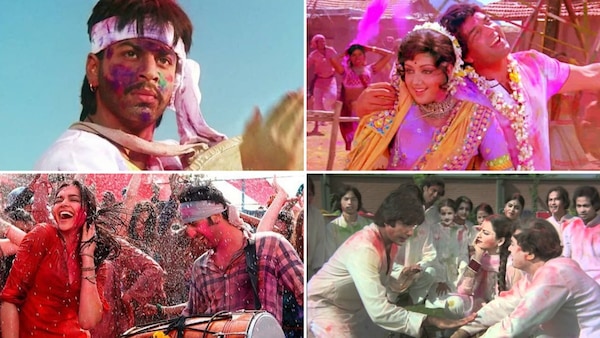Rang Barse to Balam Pichkari: How the purpose of Bollywood’s Holi songs has evolved over the years
While the classics formed an integral part of the film’s storyline, the new-age Holi tracks are peppy but seem detached from the narrative

The evolution of Bollywood Holi songs and their purpose
Last Updated: 01.20 PM, Mar 09, 2023
You may not be celebrating all the Indian festivals throughout the year, but it’s unlikely that you have not grooved to or at least tuned in to some of those iconic Holi songs from Bollywood. For the longest time, Hindi cinema reflected the life of the common man - be it that of a kisaan or a Bambai ka babu. Stories were simpler and the songs melodious. Back in the 1960s, 70s, 80s and even 90s, the exposure to global cinema was way less, and movies were primarily a source of entertainment, with songs being an integral part of the narrative.
Thus, the fun-filled, lyrical Holi delights were not simply musical breaks in between, but they rather marked an interesting turning point in the plotline. Be it Aaj Na Chodenge from Shakti Samanta’s 1971 musical hit Kati Patang, in which a white saree-clad Madhu (Asha Parekh) finally opens up to Kamal Sinha (Rajesh Khanna) or Ang Se Ang Lagana from Yash Chopra’s blockbuster film Darr, in the ending of which Sunil Malhotra (Sunny Deol) goes chasing after Rahul Mehra (Shah Rukh Khan) for forcibly smearing gulal on Kiran Awasti (Juhi Chawla). Remember the 1959 film Navrang’s Are Ja Re Hat Natkhat, picturised on Mahipal and Sandhya; Tan Rang Lo Ji Aaj Man Ranglo from Kohinoor (1960), featuring Dilip Kumar and Meena Kumari; Holi Aayi Re Kanhai from Mother India (1967), picturised on Nargis, Raaj Kumar, Rajendra Kumar and Sunil Dutt. Each of these songs perfectly dovetails with the flow of the narrative and the setting, clueing the audience into the scheme of things.
Even popular numbers like Rajesh Khanna and Mumtaz’ Jai Jai Shiv Shankar from Aap Ki Kasam (1974), Holi Ke Din - featuring Hema Malini, Dharmendra, Amitabh and Jaya Bachchan - from Sholay (1975); Holi Aayi Re from Mashaal (1984) - picturised on Dilip Kumar, Waheeda Rehman, Anil Kapoor and Rati Agnihotri - were situational and abruptly added. Again, there was Rang Barse - starring Amitabh Bachchan, Rekha, Sanjeev Kumar and Jaya Bachchan - from Silsila (1981) that triggered real-life controversies. But in the context of the film, the track was important as it led to a new twist in the plot. Counted among Bollywood’s iconic songs, these tracks are still played in full volume during every Holi party each year. Complete with alluring lyrics, peppy music and memorable videos, revellers just can’t get enough of these legendary numbers.
However, as time passed, Bollywood’s Holi songs started becoming less situational and seemed more like a quick break from the actual narrative. While the new-age Holi tracks are equally popular and groovy, do they actually fit the storyline or complement it? Perhaps, not always. Of course, we love these tracks too, but probably more for their music, choreography and the actors than experiencing them as part of the story.
While songs like Hori Khele Raghuveera from Baghban (2003) - starring Amitabh Bachchan and Hema Malini - and more recently, Lahu Munh Lag Gaya from Goliyon Ki Rasleela Ram-Leela - picturised on Ranveer Singh and Deepika Padukone - still seemed attuned to the plot, tracks such as Do Me A Favour Lets Play Holi from Waqt - The Race Against Time (2005), featuring Priyanka Chopra and Akshay Kumar; Balam Pichkari from Yeh Jawaani Hai Deewani (2013), featuring Ranbir Kapoor and Deepika Padukone; and Jai Jai Shivshankar from the 2019 film War, starring Hrithik Roshan and Tiger Shroff, look spectacular, but not really a part of the film. Again if you are someone who likes offbeat stuff, regardless of whether or not the song complements the story, there’s Rang Rang Mein from Bollywood Hollywood (2002) - picturised on Rahul Khanna and Lisa Ray. It’s a sweet romantic number that talks about Holi colours, without a splash of gulal. But the narrative would have progressed with or without these numbers. Can’t call them ornamental in the strict sense, but these songs added value only in terms of music and choreography. Thus, it’s probably safe to say that the purpose of Holi songs has evolved over the years. But is this a welcome change?
Having said that, whether Holi songs actually go with the flow of the narrative or they simply mesmerise us with their upbeat music and dance moves, no Holi party can ever be complete without a peppy Bollywood playlist!

